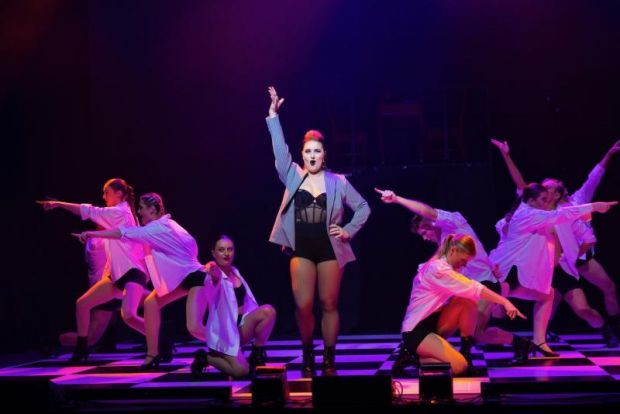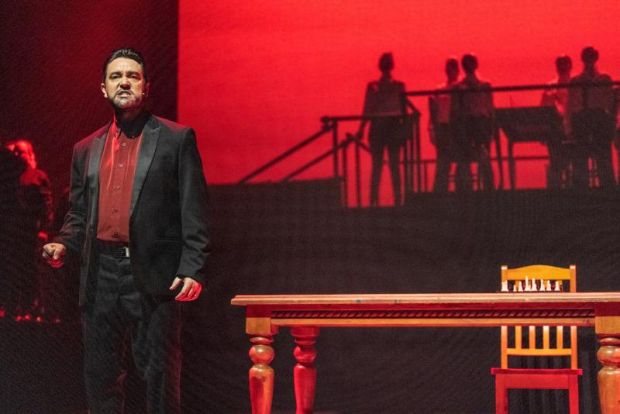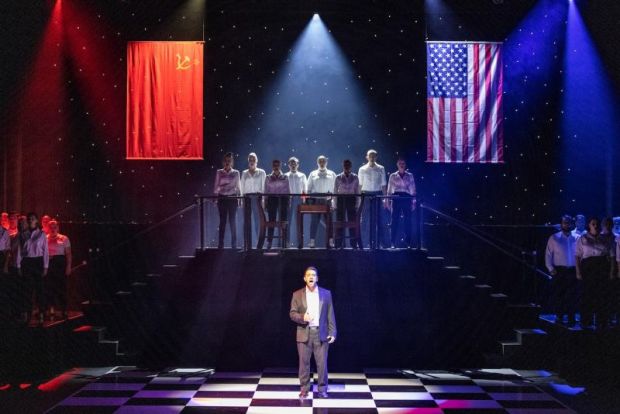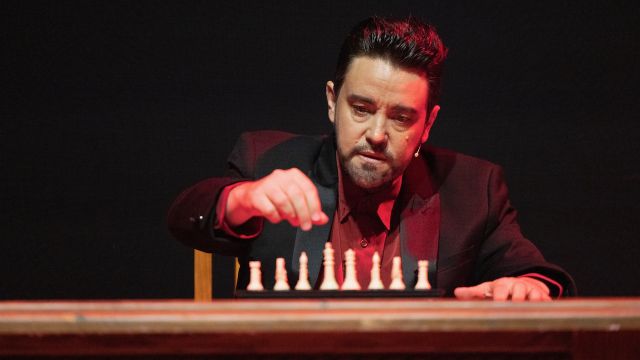CHESS
THERE IS much to celebrate in this production of a musical which – if the pun is to be pardoned – has had a chequered history. Where it lies in the chronological development of the rock opera/musical as well as its contemporary historic significance, give profound clues to the strengths and weaknesses of the show itself, which has nothing to do with this particular production.
What is there to celebrate is an interesting stylistic presentation, some fine singing voices, the debut of what will undoubtedly be a major new local talent and – above all – one of the most stunning theatre orchestras I have heard in a long while. I also had to bear in mind that I saw the final dress rehearsal, which convinced me that the cast were most definitely ready for an audience – in other words – you!
Reportedly, neither the composers nor lyricist Tim Rice (in his first major work after his partnership with Andrew Lloyd Webber split up after Evita) were entirely happy with either the West End or the much-altered Broadway production, which only ran for three months. They were a great deal happier with the successful Australian version (directed by Jim Sharman) which opened in 1990. Presumably, this is the version that we saw, as it has been suggested that there have been frequent productions which unsuccessfully tried to combine both British and American versions.
For one to truly understand this musical, the secret is to look at the time when it was written and the circumstances surrounding it. I can distinctly remember all the 1972 brouhaha surrounding the much-publicised challenge between chess-masters American Bobby Fischer and Russian Boris Spassky, which clearly inspired this musical. It was then called “The Match of the Century” and seemed to embody the challenge and threat of the Cold War, in which all Russians were regarded as potential spies and almost every contemporary Hollywood villain from the 50s to the 80s was inevitably from the Kremlin.

The genesis of this musical also gives clues to the audience’s responses to the musical. In terms of the evolution of the rock opera/musical, Chess lies somehow in the middle in terms of not only its development but also its success. It is not entirely a musical (which normally features dialogue and there was a minimal amount here) and it is not entirely an opera – which is non-stop music. And it is definitely not musical comedy – this is a dramatic musical. Jesus Christ Superstar paved the way for productions such as Evita (always for me the best of the Webber/Rice collaborations), and eventually reached to the heights of Les Misérables and latterly Hamilton. Like Superstar and Evita, Chess had its origins with the concept album which lead to stage productions.
That stunning concept album was released in 1984 (my vinyl copy was worn out by 1985) and produced two major hit singles – Murray Head singing "One Night in Bangkok" and the ever-popular Elaine Paige/Barbara Dickson duet, "I Know Him So Well." The sales of the concept album and these two singles financed the first production which opened in the West End in 1986 to mixed and variable reviews, but managing to run for three years.
This is the first production I have seen of this musical, and I must confess that the trouble with a concept album is that – like a book – one’s own imagination can sometimes create powerful pictures of how it would or could be staged. The visual impact of this production was thankfully powerful enough to shoo away those notions with a strong stylistic interpretation, dominated by a set and costuming in black, white and red, echoing the colours used on a chessboard.
This colour dominance was mostly successful – with an occasional costuming design hiccup – but the entire production not only required a vision that was visual and auditory, but should also flow into a stylistic and disciplined presentation of the movement - particularly of the chorus work.
This stylisation of movement worked magnificently in the interpretation of the chess game with the actual players/actors on an upstage platform while the chess-game was wonderfully interpreted in stylised choreography with dancers on a giant centre stage chessboard, which also formed the main acting area. This choreography and costuming of these sequences – in both acts – was in perfect keeping with the pursuit of style.

This stylistic movement of the chorus was a bit haphazard in Act One with a confusing mixture of naturalistic and semi-formalised movement. However, Act Two blasted us with the terrific opening of "One Night in Bangkok". Staged predominantly in red and black, this sequence not only identified but also nailed the movement style which should have characterised the rest of the production.
Where the challenge lies in Chess is to find the intensity of emotions to ”fill the gaps” as it were. This helps the story move along, give us insight into the characters and their motivations as well as provide the audience with access points to a production characterised by style. It is simply not enough to stage any production – particularly musicals - without giving credence and direction to the themes explored and the characters’ emotional states. After all, one could not today stage Rodgers and Hammerstein’s Carousel or South Pacific without seriously looking at domestic violence or racial issues.
Chess is a political drama against the backdrop of the Cold War about a chess tournament between two grandmasters – one American and one Soviet – and their fight over a woman who works for one and falls in love with the other. Understanding the ramifications of the Cold War is not easy all these years later, but finding the dramatic intensity is provided from clues in the extreme contemporary suspicion and near-hatred which existed then between the USA and USSR.
Not only is this perfectly represented by foes on a chess board but it also gives an added dimension to the characters’ inner lives and provides vital emotional clues for the characters. In this, the script itself is flawed as it does not necessarily fully explore these opportunities, so it is really left up to the director find the opportunities to flesh out the characters.
In true Elaine Paige tradition, the singing voice of Jill Cason as Florence rang bell-like throughout the theatre. She achieved her first vocal heights with Act One’s "Nobody’s Side" and "Heaven Help My Heart" so by the time we had Act Two’s "I Know Him So Well", expectations were high – and she vocally delivered on all accounts. This demanding role requires a clear dramatic journey, delivered almost entirely through song. As the evening progressed she became more comfortable with delivering the character’s emotional complexities and journey.
Josh Palmer is an outstanding singer of enormous range and talent and this is second time out for him as Anatoly Sergievsky, the Russian grandmaster. Clearly, he knew the vocal intricacies of the demanding role and his Act One "Anthem" was a highlight. His challenge lay in finding the anger and passion of the role, which leads to the audience’s clearer understanding of his emotional journey.

Sam Taylor made a good stab at the Bobby Fischer-esque character, Frederick Trumper, but he too was faced with finding the character’s anger and passion so we could respond in kind. Vocally, he was also a pleasure, and he clearly enjoyed his "One Night in Bangkok" number.
However, acting honours for the evening must undoubtedly go to what I can only describe as a stunning major debut for local actor Jakaya Drysdale as Svetlana. There is great dramatic power to be found in stillness and her stage presence, stature and command of the stage was unquestionable. Her complete understanding of her character, motivation and circumstance lent a quality to her "Someone Else’s Story" song in Act Two to make a not-very-well-known song stand out in terms of emotional delivery. This was a goose-bump producing moment and it made the production soar.
Other performances of note included Richard Brown as Alexander Molokov, completely reminiscent in tone and delivery of German bass singer Ivan Rebroff, extremely popular in the 60s and 70s; and Mikka Ewens as The Arbiter.
Finally, one cannot complete this review without paying tribute to the excellence of the theatre orchestra – a 25-piece group under the baton of musical director Odette Baxter. Not a wrong note nor a sound imbalance. As a fellow critic said that night, “I have run out of superlatives to describe our theatre orchestras.“ And that about sums it up!
Ultimately my advice? This is a courageous production with some extraordinary moments which are worth the entire evening.
Trevor Keeling
Photographer: Dee Kirkman of Sapphire Soul Photography
Subscribe to our E-Newsletter, buy our latest print edition or find a Performing Arts book at Book Nook.

